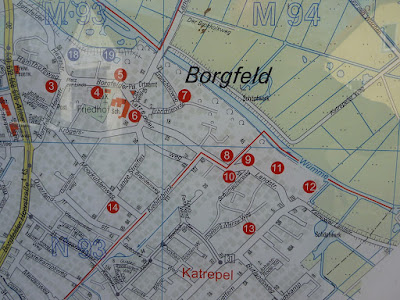 |
| Borgfelder Wümmewiesen with Deichschlot, Bremen-Borgfeld, Germany |
Borgfeld's development began as a rural settlement at the Wümme River about 800 years ago. It became a district of the city of Bremen, Germany, in 1945. This quaint neighborhood can easily be accessed from downtown Bremen by tram. Line 4 takes you there. From the Borgfeld tram stop it only takes a short walk to get to Borgfeld's center around the church with a history going back to the 13th century.
 |
| Building of the Wümmehof complex |
 |
| Map of Borgfeld highlighting points of interest |
By now, you certainly have realized that Borgfeld is more than an ordinary village-turned-suburb district. If you mainly came to see the open-space wetlands, you are almost there. The Katrepeler Landstraße continues on a levee. It turns into Am Hollerdeich (Deich meaning levee) and soon you will arrive at the Beobachtungsstand Hollerdeich—an observation tower on the right side of the road.

 |
| Hollerdeich observation tower |
From the top of this small tower, one can enjoy great views of the Borgfelder Wümmewiesen, Bremen's largest nature preserve. The Wümme River is gently traversing the meadows. Various ponds and canals can be seen on both sides of the main river. The canal next to the levee is called Deichschlot—its name expresses that it is extending alongside the levee. During winter months, the meadows are often flooded.
The Wümmewiesen were agriculturally used in the past, but since 1987 they constitute a federally supported nature preserve. It is ecologically important, as various endangered plants and birds make this wetland their habitat. Other birds are passing through during migration. The small number of native Fischotter—Old World otters (Lutra lutra)—are living from fish they find in the streams and streamlets.
A panel at the observation tower informs about the locally endangered Sumpfdotterblume—marsh-marigold (Caltha palustris)—with its nectar-rich yellow flowers, which attract diverse insect species. The seeds contain small air pockets, such that the seeds float on water and promote the plant's spreading along river banks. Water birds also disperse the seeds, resulting in a marigold-dotted marsh during the spring season.
 |
| Map of Bremen's largest nature preserve: the Borgfelder Wümmewiesen |
Suggested browsing and reading
[1] Freie Hansestadt Bremen, Ortsamt Borgfeld: Borgfeld ein Dorf mit Geschichte [www.ortsamt-borgfeld.de/sixcms/detail.php?gsid=bremen150.c.1699.de].
[2] Schutzgebiete im Land Bremen: Borgfelder Wümmewiesen [www.erlebnisraum-natur.de/fileadmin/user_upload/bilder/Publikationen/Faltblaetter/NSG-Borgfelder-Wuemmewiesen.pdf].














No comments:
Post a Comment